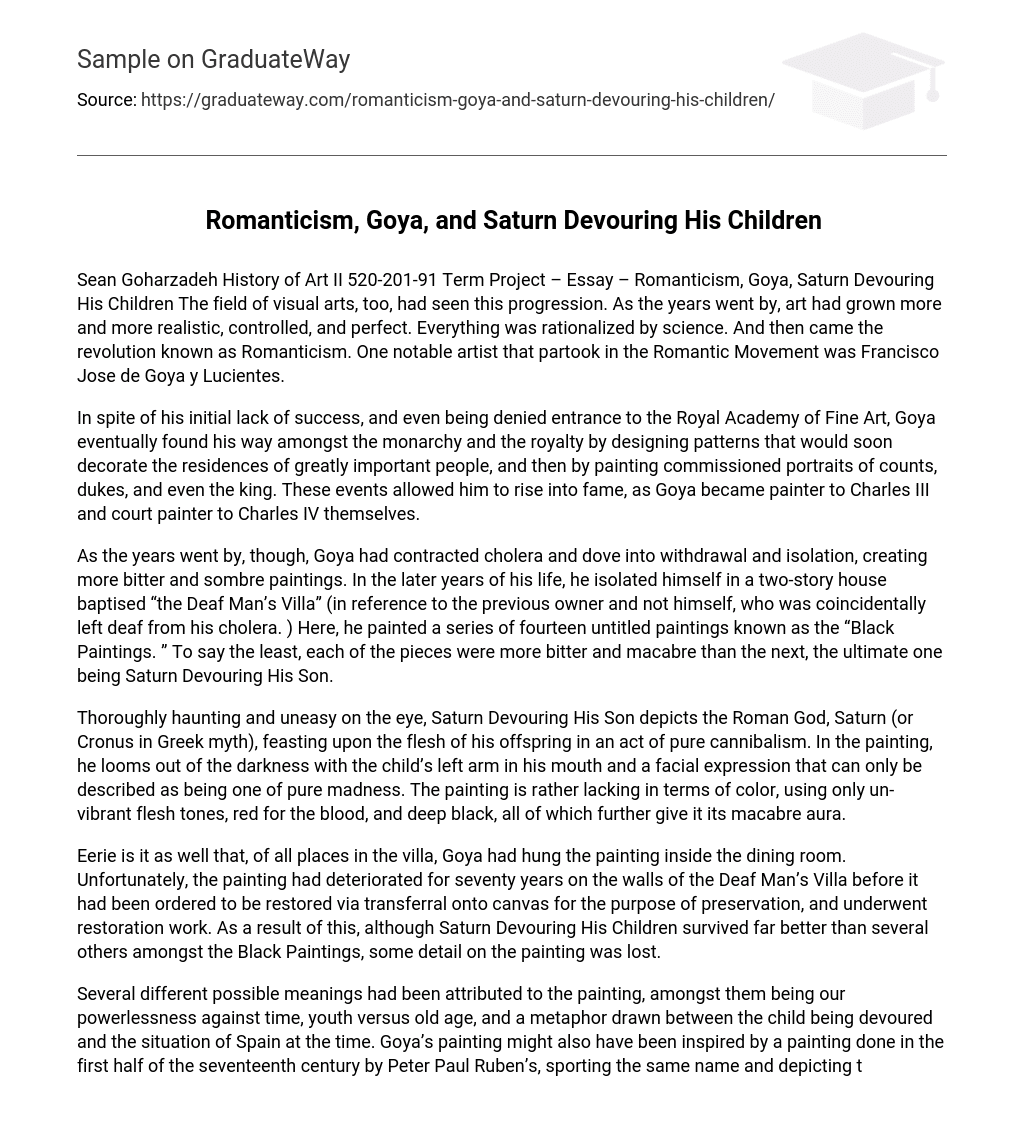The field of visual arts, too, had seen this progression. As the years went by, art had grown more and more realistic, controlled, and perfect. Everything was rationalized by science. And then came the revolution known as Romanticism. One notable artist that partook in the Romantic Movement was Francisco Jose de Goya y Lucientes.
In spite of his initial lack of success, and even being denied entrance to the Royal Academy of Fine Art, Goya eventually found his way amongst the monarchy and the royalty by designing patterns that would soon decorate the residences of greatly important people, and then by painting commissioned portraits of counts, dukes, and even the king. These events allowed him to rise into fame, as Goya became painter to Charles III and court painter to Charles IV themselves.
As the years went by, though, Goya had contracted cholera and dove into withdrawal and isolation, creating more bitter and sombre paintings. In the later years of his life, he isolated himself in a two-story house baptised “the Deaf Man’s Villa” (in reference to the previous owner and not himself, who was coincidentally left deaf from his cholera. ) Here, he painted a series of fourteen untitled paintings known as the “Black Paintings. ” To say the least, each of the pieces were more bitter and macabre than the next, the ultimate one being Saturn Devouring His Son.
Thoroughly haunting and uneasy on the eye, Saturn Devouring His Son depicts the Roman God, Saturn (or Cronus in Greek myth), feasting upon the flesh of his offspring in an act of pure cannibalism. In the painting, he looms out of the darkness with the child’s left arm in his mouth and a facial expression that can only be described as being one of pure madness. The painting is rather lacking in terms of color, using only un-vibrant flesh tones, red for the blood, and deep black, all of which further give it its macabre aura.
Eerie is it as well that, of all places in the villa, Goya had hung the painting inside the dining room. Unfortunately, the painting had deteriorated for seventy years on the walls of the Deaf Man’s Villa before it had been ordered to be restored via transferral onto canvas for the purpose of preservation, and underwent restoration work. As a result of this, although Saturn Devouring His Children survived far better than several others amongst the Black Paintings, some detail on the painting was lost.
Several different possible meanings had been attributed to the painting, amongst them being our powerlessness against time, youth versus old age, and a metaphor drawn between the child being devoured and the situation of Spain at the time. Goya’s painting might also have been inspired by a painting done in the first half of the seventeenth century by Peter Paul Ruben’s, sporting the same name and depicting the same event in the myth. In Ruben’s version though, Saturn lacks the mad look, with a cold and calculating facial expression in turn occupying his face.
So too is the child in Ruben’s version a genuine baby, as opposed to the rather adult-looking androgynous figure depicted on Goya’s version. Evidence of Goya’s inspiration on Ruben’s painting is further advanced by the fact that he had also done a chalk drawing of the same subject decades earlier, depicting a Saturn that resembles Ruben’s a lot more and notably absent of blood and madness, much like Ruben’s once more. Although Francisco Goya died only a few years after his completion of the Black Paintings, his legacy lived on within many artists, including but not limited to Manet and Picasso.
It can be said, in conclusion, that Goya set one of the milestones in the history of art by being amongst the first to truly depict what was in the innermost recesses of his own mind.
Bibliography
- WEEMS, Erik. “Saturn” Goya. 12 May 2009 http://eeweems. com/goya/saturn. html.
- “Goya (y Lucientes), Francisco (Jose) de. ” WebMuseum, Paris. 12 May 2009 http://www. ibiblio. org/wm/paint/auth/goya/





